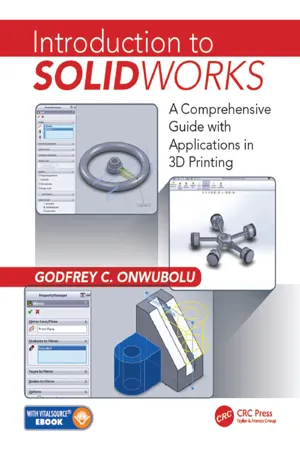
Introduction to SolidWorks
A Comprehensive Guide with Applications in 3D Printing
- 1,165 pages
- English
- ePUB (mobile friendly)
- Available on iOS & Android
Introduction to SolidWorks
A Comprehensive Guide with Applications in 3D Printing
About This Book
This senior undergraduate level textbook is written for Advanced Manufacturing, Additive Manufacturing, as well as CAD/CAM courses. Its goal is to assist students in colleges and universities, designers, engineers, and professionals interested in using SolidWorks as the design and 3D printing tool for emerging manufacturing technology for practical applications. This textbook will bring a new dimension to SolidWorks by introducing readers to the role of SolidWorks in the relatively new manufacturing paradigm shift, known as 3D-Printing which is based on Additive Manufacturing (AM) technology.
This new textbook:
- Features modeling of complex parts and surfaces
- Provides a step-by-step tutorial type approach with pictures showing how to model using SolidWorks
- Offers a user-Friendly approach for the design of parts, assemblies, and drawings, motion-analysis, and FEA topics
- Includes clarification of connections between SolidWorks and 3D-Printing based on Additive Manufacturing
- Discusses a clear presentation of Additive Manufacturing for Designers using SolidWorks CAD software
"Introduction to SolidWorks: A Comprehensive Guide with Applications in 3D Printing" is written using a hands-on approach which includes a significant number of pictorial descriptions of the steps that a student should follow to model parts, assemble parts, and produce drawings.
Frequently asked questions
Information
17
Mold Design
Mold Design Background
Table of contents
- Cover
- Half Title
- Title Page
- Copyright Page
- Dedication
- Table of Contents
- Preface
- Acknowledgments
- Author
- Section I Introductory Engineering Design Principles with SolidWorks
- Section II Intermediate Engineering Design Principles with SolidWorks
- Section III Engineering Design Practice with SolidWorks
- Section IV Introductory 3D Printing
- Index